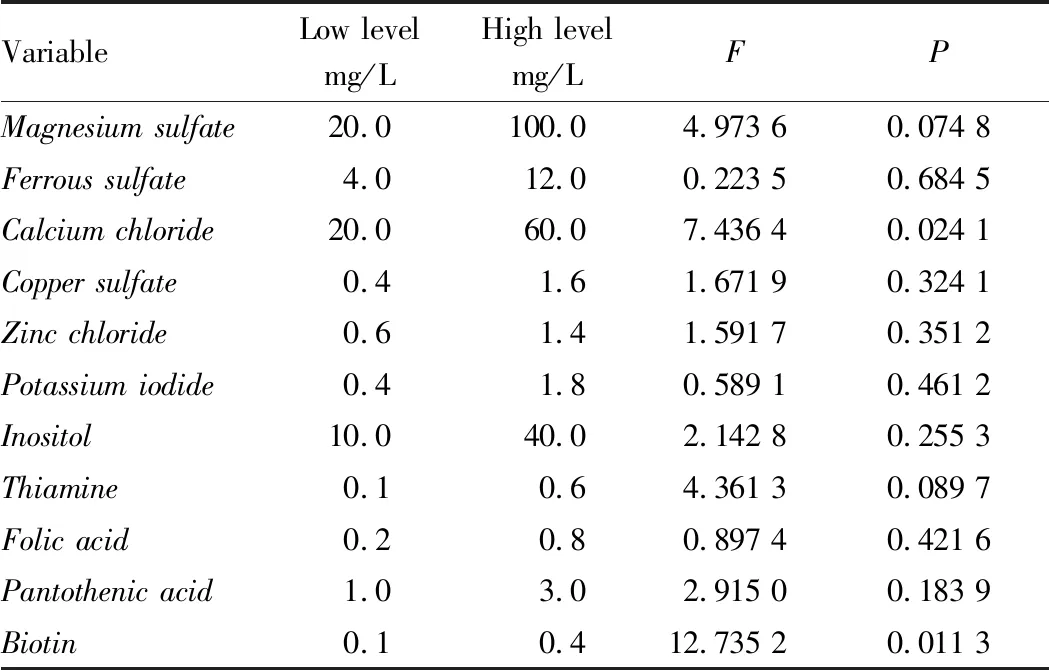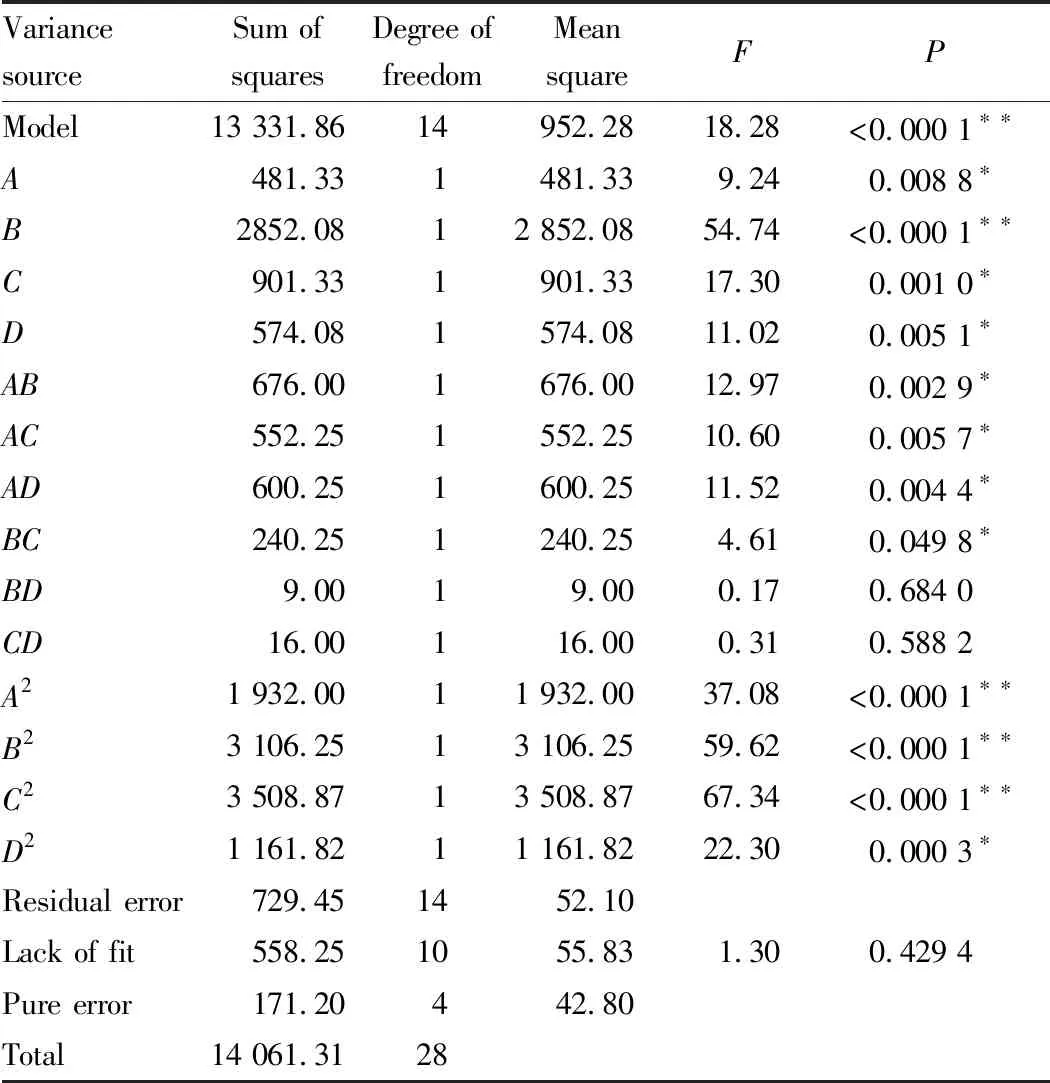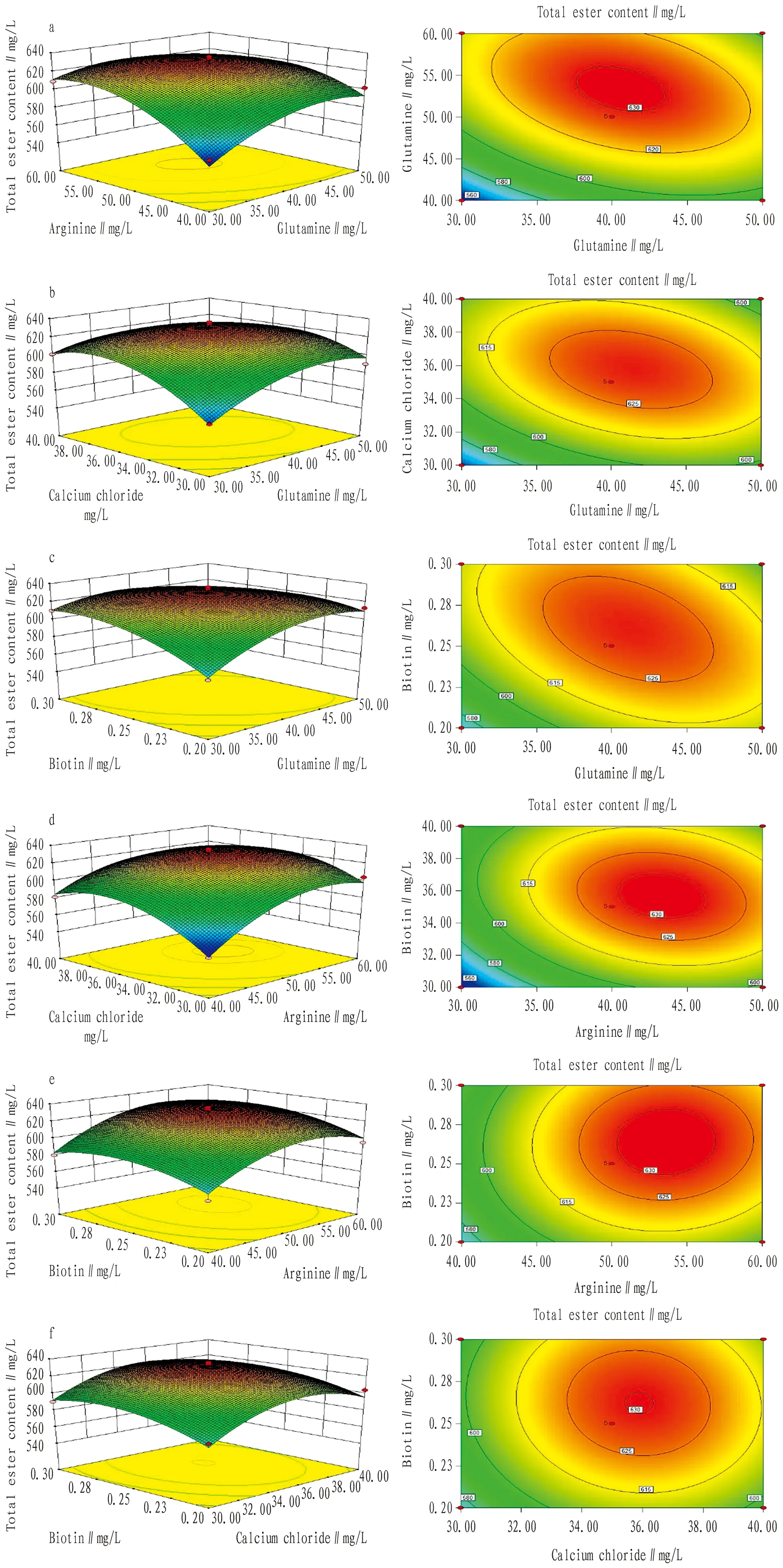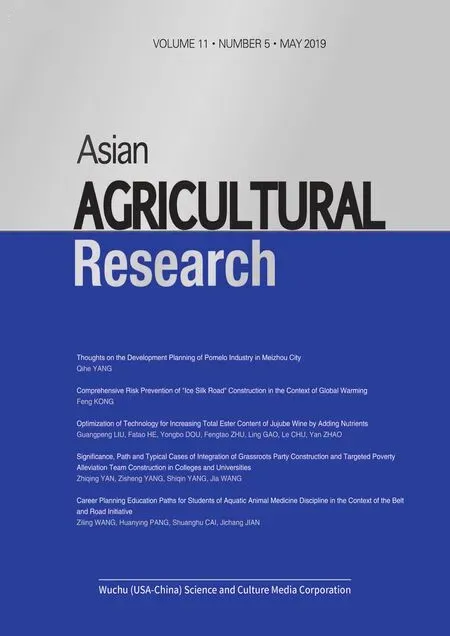Optimization of Technology for Increasing Total Ester Content of Jujube Wine by Adding Nutrients
2019-06-27GuangpengLIUFataoHEYongboDOUFengtaoZHULingGAOLeCHUYanZHAO
Guangpeng LIU, Fatao HE, Yongbo DOU, Fengtao ZHU, Ling GAO, Le CHU, Yan ZHAO
Jinan Fruit Research Institute, All China Federation of Supply and Marketing Cooperatives, Jinan 250014, China
Abstract Using jujube juice prepared from red jujube as raw material and Saccharomyces cerevisiae as experimental strain, the effect of nutrients on the content of total ester in jujube wine was studied. The nutrients affecting the total ester content of jujube wine were glutamine, arginine, calcium chloride and biotin by Plackett-Burman design. Through the steepest ascent test, it was determined that the central points of the optimum addition of nutrients were glutamine 40 mg/L, arginine 50 mg/L, calcium chloride 35 mg/L and biotin 0.25 mg/L, respectively. Through Box-Behnken experiment design, taking glutamine, arginine, calcium chloride and biotin as experimental factors, and the content of total ester in jujube wine as response value, the response surface optimization experiment was carried out and the verification experiment was also carried out. It was found that the response surface model can be used to predict the total ester content of jujube wine when nutritional elements were added. When the content of total ester in jujube wine was the highest, the optimal combination of nutrients was glutamine 38.8 mg/L, arginine 53.8 mg/L, calcium chloride 35.7 mg/L and biotin 0.3 mg/L. At this point, the content of total ester in jujube wine was 628 mg/L, which was very close to the predicted value. Through the sensory evaluation of jujube wine, it was found that adding nutrients could help to improve the taste of jujube wine, and the fermentation method of jujube wine by adding nutrients was simple and feasible.
Key words Nutrients, Improvement, Jujube wine, Total ester
1 Introduction
Jujube (ZiziphusjujubaMill.), also known as red date, is rich in amino acids, trace elements and vitamins. Jujube can be used as medicine and food[1-2], with the effects of nourishing qi and replenishing blood, anti-fatigue, reducing cholesterol and so on[3-4]. Jujube wine is a deeply processed product of red jujube, which has a certain value of nutrition and health care. It has a history of nearly a thousand years in China, but it has a low degree of industrialization because of its poor quality and flavor[5-6]. The low content of esters and mediocre flavor are the important factors affecting the taste of jujube wine. There is a great correlation between the formation of esters and the composition and content of nutrients in the fermentation broth during the growth and metabolism ofSaccharomycescerevisiae[7-9]. Bellsetal. found that the type and concentration of nitrogen sources had an important effect on the content of esters, fatty acids and other flavor substances in wine fermentation[10]. Schmidtetal.[11]reported that during the fermentation of Chardonnay wine, the level of potassium had a significant effect on the fermentation performance ofS.cerevisiaeand the quality of wine. P. Hernández-Orteetal.[12]found that adding appropriate concentration of amino acids to grape juice played a positive role in promoting the formation of alcohol and esters, so as to improve the flavor and taste of wine.
The purpose of this study was to optimize the types and content of nutrient elements (amino acids, trace elements and growth factors) in jujube juice, and to determine the optimal content of nutrients in jujube wine fermentation, and improve the level of esters in jujube wine to solve the problem of insufficient aroma and further improve the quality of jujube wine.
2 Materials and Methods
2.1 Strains and MediaSaccharomycescerevisiaeCTCF0001: preserved in the Fermentation Technology Research Room of China Fruit and Vegetable Storage and Processing Technology Research Center.
Seed medium: yeast extract 10 g/L, glucose 20 g/L, peptone 20 g/L, natural pH value, steam sterilization at 115℃ for 30 min.
2.2 Main test materials and reagentsGrey jujube: provided by Xinjiang Tiankun Fruit Industry Co., Ltd. Pulp enzyme: Novozymes Biotechnology Co., Ltd. Trace elements: magnesium sulfate, ferrous sulfate, calcium chloride, copper sulfate, zinc chloride, potassium iodide and other analytical pure reagents. Growth factors: inositol, thiamine, folic acid, pantothenic acid, biotin and other analytical pure reagents. Amino acids: aspartic acid, threonine, glutamine, leucine, arginine, histidine, phenylalanine, valine, isoleucine, lysine, serine and other analytical pure reagents.
2.3 Instruments and devicesTRACE 1300 gas chromatography-mass spectrometry (Thermo); solid phase microextraction device (manual injector and 50/30 μm DVB/CAR/PDMS extraction head) (Qingdao Zhenzheng Analytical Instrument Co., Ltd.; automatic vertical pressure steam sterilizer (Shanghai Boxun Medical Biological Instrument Co., Ltd.); biochemical incubator (Shanghai Zhicheng Analytical Instrument Manufacturing Co., Ltd.); electronic analysis balance (Mettler-Toledo Instrument (Shanghai) Co., Ltd.); pipette (Eppendorf, Germany).
2.4 Test methods
2.4.1Preparation of jujube juice. After weighing and cleaning, the raw jujube was mixed with water according to the mass ratio of 1∶3.5, heated, and boiled for 15 min, beaten, washed and cooled to 50℃. Then 1/10 000 pulp enzyme was added for 90 min enzymolysis to extract juice and mix, and jujube juice was set aside for later use.
2.4.2Fermentation experiment of jujube wine. According to the experimental design, the corresponding nutritional factors were added to jujube juice. The expandedS.cerevisiaeCTCF0001 seed liquid was inoculated into the corresponding jujube juice according to a certain amount. Fermentation was carried out in a constant temperature incubator at 25℃ until the residual total sugar in the fermentation broth was less than 0.5%. At the end of fermentation, the residual sugar, alcohol content and total ester content in the fermentation broth were determined[13-14]. The corresponding aroma components were analyzed.
2.4.3Plackett-Burman test design. On the basis of single factor preliminary experiment, Plackett-Burman experiment design was carried out by using Minitab 17.0 software. Taking the total ester content of jujube wine as the response value, 11 amino acids (aspartic acid, threonine, glutamine, leucine, arginine, histidine, phenylalanine, valine, isoleucine, lysine and serine) affecting the total ester content of jujube wine were screened. Six trace elements (magnesium sulfate, ferrous sulfate, calcium chloride, copper sulfate, zinc chloride, potassium iodide) and five growth factors (inositol, thiamine, folic acid, pantothenic acid, biotin) were screened. For each factor, 1 and -1 were taken as high and low levels, and each experiment was repeated three times, and the average value was taken as the experimental results. The difference in the level of factors as well as the overall difference was compared to achieve the screening of significant factors[15]. Through the steepest ascent experiment, the possible regional center points of the important factors were obtained[16].
2.4.4Box-Behnken test design. According to Plackett-Burman, the significant factors affecting the content of total ester in jujube wine fermentation were selected, and the parameters affecting the content of total ester in jujube wine fermentation were further optimized by response surface method (Box-Behnken experimental design). The optimal level of each nutrient at the maximum response value was obtained.
2.5 Sensory evaluation of jujube wineBy using the percentile method, 10 trained sensory evaluators with relevant experience were selected to form a sensory evaluation team. The sensory evaluation of each wine sample was carried out from four aspects: color (20 points), aroma (30 points), taste (30 points) and typicality (20 points). The sum of the average scores was the final sensory score[17-18].
2.6 Statistical analysisThe Plackett-Burman experiment design and data analysis were carried out with Minitab 17.0 software, and the response surface optimization design and data analysis were carried out with Design Expert 8.0 software.
3 Results and analysis
3.1 Plackett-Burman test resultsAccording to the design of Plackett-Burman experiment, the content of total ester in jujube wine was taken as the response value, and the experiment was conducted 12 times. The influencing factors of 11 amino acids including aspartic acid, threonine, glutamine, leucine, arginine, histidine, phenylalanine, valine, isoleucine, lysine and serine were investigated. Two levels were taken for each factor, and the experimental design and results are shown in Table 1.
According to the Plackett-Burman experiment design, the experiment was conducted 12 times. Six trace elements (magnesium sulfate, ferrous sulfate, calcium chloride, copper sulfate, zinc chloride, potassium iodide) and five growth factors (inositol, thiamine, folic acid, pantothenic acid and biotin) were investigated. Two levels were taken for each factor, and the experimental design and results are shown in Table 2. The experiment was carried out according to the experimental design of Plackett-Burman.
According to the experimental results in Table 1 and Table 2, there were four nutrients which had significant effects on the content of total ester in jujube wine, which included glutamine (P=0.014 5), arginine (P=0.022 4), calcium chloride (P=0.024 1) and biotin (P=0.011 3).
Table 1 Plackett-Burman test design and results of amino acids

VariableLow levelmg/LHigh levelmg/LFPAspartic acid20505.401 80.061 3Threonine15451.897 20.209 6Glutamine20709.324 60.014 5Leucine10302.145 30.188 5Arginine30808.452 50.022 4Histidine20400.623 60.447 8Phenylalanine10300.945 40.416 7Valine20500.081 40.752 6Isoleucine20402.913 10.153 2Lysine10200.517 60.466 4Serine10401.564 50.219 2
Table 2 Experimental design and results of trace elements and growth factors

VariableLow levelmg/LHigh levelmg/LFPMagnesium sulfate20.0100.04.973 60.074 8Ferrous sulfate4.012.00.223 50.684 5Calcium chloride20.060.07.436 40.024 1Copper sulfate0.41.61.671 90.324 1Zinc chloride0.61.41.591 70.351 2Potassium iodide0.41.80.589 10.461 2Inositol10.040.02.142 80.255 3Thiamine0.10.64.361 30.089 7Folic acid0.20.80.897 40.421 6Pantothenic acid1.03.02.915 00.183 9Biotin0.10.412.735 20.011 3
3.2 Steepest ascent testFour important factors, glutamine, arginine, calcium chloride and biotin, which had a significant effect on the total ester content of jujube wine, were selected for the steepest ascent test. According to the variable relationship between important factors in the process of the factor optimization experiment[19], glutamine and calcium chloride had positive effects, while arginine and biotin had negative effects. According to the experimental results shown in Table 3, the experimental serial number 4 was the nutrient addition condition for the highest total ester content in jujube wine fermentation, and the optimal condition was used as the central point of the subsequent response surface optimization experiment to carry out the response surface optimization experiment.
Table 3 Design and results of steepest ascent test

mg/L
3.3 Response surface optimization experiment
3.3.1Response surface analysis scheme, experimental results and analysis of variance. According to the principle of Box-Behnken experimental design, the total ester content (Y) in jujube wine was taken as the response value. Based on the results of Plackett-Burman experiment, four factors, glutamine, arginine, calcium chloride and biotin, which had significant effects on the content of total ester in jujube wine, were investigated. Taking the best point of experimental factors determined by the steepest ascent test as the central point of the factors, thesof four-factor and three-level response surface optimization experiment was carried out. The experimental design factor and level values are shown in Table 3, and the experimental design and results are shown in Table 4.
Table 4 Factors and levels of response surface experimental design

FactorsCodesLevels-101GlutamineA304050ArginineB405060Calcium chlorideC303540BiotinD0.200.250.30
The experimental results of Table 4 went through regression and fitting analysis. The regression equation of total ester content to four factors was obtained:
Y=628.60+6.33A+15.42B+8.67C+6.92D-13.00AB-11.75AC-12.25AD-7.75BC+1.50BD-2.00CD-17.26A2-21.88B2-23.26C2-13.38D2.
The analysis of variance of the regression model (Table 5) showed that the quadratic regression model could significantly fit the effects of glutamine, arginine, calcium chloride and biotin on the content of total ester in jujube wine, and could replace the real point of the experiment to analyze the results.
Table 5 Box-Behnken experimental design results

Test serialnumberABCDTotal ester content∥mg/LActual valuePredicted value1-1-10056155521-1006025933-110060961241100598598500-1-15785746001-1604596700-11590592800116086069-100-157057210100-161361011-1001610611121001604599130-1-105515521401-10604598150-11058158416011060360017-10-105625611810-1059059719-1010601602201010582591210-10-156557222010-1595600230-101580583240101616617250000620629260000628629270000634629280000636629290000625629
Arginine (B), glutamine secondary term (A2), arginine secondary term (B2) and calcium chloride quadratic term (C2) had highly significant effects on the content of total ester in jujube wine. Glutamine (A), calcium chloride (C), biotin (D), interaction item between glutamine and arginine (AB), interaction item between glutamine and calcium chloride (AC), interaction item between glutamine and biotin (AD), interaction item between arginine and calcium chloride (BC) had a significant effect on the content of total ester in jujube wine. The interaction item between arginine and calcium chloride (BC), interaction item between calcium chloride and biotin (CD) had no significant effect on the content of total esters in jujube wine.
The value ofFindicates the influence of different factors on the content of total ester in jujube wine. The larger theFvalue of the factor is, the stronger the effect of this factor on the response value is[20]. Therefore, it was found that the order of the effect of nutrients on the content of total ester in jujube wine was arginine> calcium chloride>biotin>glutamine.
3.3.2Response surface and contour analysis. Based on the regression equation fitting analysis of the experimental results in Table 4, the response surface and contour map of the interaction between the two factors to the total ester content of jujube wine can be obtained. The gentle slope of the response surface showed that the factors had little influence on the response value, and the contours were circular, indicating that the interaction between the two factors was weak, while it was the other way around when the slope was steep and the contours were oval[20-21]. It can be seen from Fig.1 that glutamine, arginine, calcium chloride and biotin had significant effects on the total ester content of jujube wine. The interaction term between glutamine and arginine (AB), interaction term between glutamine and calcium chloride (AC), interaction term between glutamine and biotin (AD) and interaction term between arginine and calcium chloride (BC) had significant effects on the content of total esters in jujube wine. The interaction term between arginine and calcium chloride (BC), interaction term between calcium chloride and biotin (CD) had no significant effect on the content of total esters in jujube wine.
3.3.3Prediction and verification of optimal process conditions. After software optimization and prediction, the optimal nutrient combinations with total ester content of jujube wine as response value were glutamine 38.80 mg/L, arginine 53.75 mg/L, calcium chloride 35.70 mg/L and biotin 0.27 mg/L. Under these optimum conditions, the total ester content in jujube wine was predicted to be 632.832 mg/L. According to the feasibility of the actual experiment, the combinations of nutrients were glutamine 38.8 mg/L, arginine 53.8 mg/L, calcium chloride 35.7 mg/L and biotin 0.3 mg/L. The experiment was carried out to verify the optimal combination of nutrients predicted by the model. The experiment was repeated three times, and the mass concentration of total ester in jujube wine was 628 mg/L, which was close to the predicted result of the model at 632.832 mg/L. The results showed that the optimal combination of nutrients in jujube wine fermentation optimized by response surface method was reliable.
3.3.4Physicochemical analysis and sensory evaluation of jujube wine. The physicochemical analysis and sensory evaluation of jujube wine prepared according to the previous process and optimized technology were carried out, and the data were analyzed. The results are shown in Table 6 and 7. According to the detection results of jujube wine in Table 6, it was found that the total ester content of jujube wine fermented with nutrients was significantly higher than that of jujube wine without nutrients. The residual total sugar content of jujube wine with nutrients decreased, indicating that the addition of nutrients was beneficial to the production of esters and the consumption of total sugar bySaccharomycescerevisiaeto improve the alcohol content of jujube wine. The changes of pH, total acid and alcohol content in jujube wine were not significant, which showed that the addition of nutrients had little effect on the pH value, total acid and alcohol content of jujube wine. According to the sensory evaluation of jujube wine in Table 7, the total ester content of jujube wine fermented with nutrients was significantly increased, the aroma of jujube wine was significantly improved, and the taste of jujube wine was also greatly improved. The overall evaluation showed that adding nutrients could help to improve the sensory quality of jujube wine, and this method was simple and feasible.
Table 6 Analysis of variance of regression model

Variance sourceSum ofsquaresDegree offreedomMeansquareFPModel13 331.8614952.2818.28<0.000 1∗∗A481.331481.339.240.008 8∗B2852.0812 852.0854.74<0.000 1∗∗C901.331901.3317.300.001 0∗D574.081574.0811.020.005 1∗AB676.001676.0012.970.002 9∗AC552.251552.2510.600.005 7∗AD600.251600.2511.520.004 4∗BC240.251240.254.610.049 8∗BD9.0019.000.170.684 0CD16.00116.000.310.588 2A21 932.0011 932.0037.08<0.000 1∗∗B23 106.2513 106.2559.62<0.000 1∗∗C23 508.8713 508.8767.34<0.000 1∗∗D21 161.8211 161.8222.300.000 3∗Residual error729.451452.10Lack of fit558.251055.831.300.429 4Pure error171.20442.80Total14 061.3128
Note:*Pr>Fvalue less than 0.000 1 is highly significant;*Pr>Fvalue less than 0.000 1 is significant;R=0.973 7,R2=0.948 1.
Table 6 Results of physicochemical indexes of jujube wine

CategoryResidual total sugar∥g/LpH valueTotal acid∥g/LAlcohol content∥%Total ester content∥mg/LWithout addition5.62±0.11a4.36±0.12a3.31±0.12a11.90±0.15a534±11aAddition5.14±0.14a4.30±0.13b3.24±0.09a12.05±0.10b628±9a
Table 7 Sensory indexes of jujube wine

CategoryColorAromaTasteTypicalityTotal scoreWithout addition19.0±0.86a23.0±1.55a21.5±1.10a18.0±0.84a81.5±4.22aAddition18.0±1.02a27.5±0.95b25.0±0.78a18.5±0.65b89.0±2.77b

Note: a: glutamine addition and arginine addition; b: glutamine addition and calcium chloride addition; c: glutamine addition and biotin addition; d: arginine addition and calcium chloride addition; e: arginine addition and biotin addition; f: calcium chloride addition and biotin addition.
Fig.1 The effect of interaction between two factors on the content of total ester in jujube wine
4 Conclusions
The nutrients affecting the total ester content of jujube wine were glutamine, arginine, calcium chloride and biotin by Plackett-Burman test. Through the steepest ascent test, it was determined that the central points of the optimum addition of nutrients were glutamine 40 mg/L, arginine 50 mg/L, calcium chloride 35 mg/L and biotin 0.25 mg/L, respectively. Through the Box-Behnken experimental design, taking glutamine, arginine, calcium chloride and biotin as experimental factors, and the total ester content in jujube wine as the response value, the response surface optimization experiment was carried out and the verification experiment was carried out. It was derived that the response surface model could be used to predict the total ester content of jujube wine when nutritional factors were added. When the content of total ester in jujube wine was the highest, the optimal combinations of nutrients were glutamine 38.8 mg/L, arginine 53.8 mg/L, calcium chloride 35.7 mg/L and biotin 0.3 mg/L. At this time, the content of total ester in jujube wine was 628 mg/L, which was very close to the predicted value. Through the sensory evaluation of jujube wine, it was found that adding nutrients could help to improve the taste of jujube wine, and had little effect on the basic physical and chemical indexes of jujube wine. The fermentation method of jujube wine with nutrients was simple and feasible.
杂志排行
Asian Agricultural Research的其它文章
- Career Planning Education Paths for Students of Aquatic Animal Medicine Discipline in the Context of the Belt and Road Initiative: A Case Study of Construction Achievement of Guangdong Ocean University
- Effects of Different Herbicides on the Control of Malachium aquaticum L. and Poa annua L.
- Screening and Simple Identification of Drought-resistant Lines in Sugarcane Breeding
- Comprehensive Risk Prevention of "Ice Silk Road" Construction in the Context of Global Warming
- Childcare, Elderly Caring and Off-farm Employment of Rural Couples in China
- Regional Advantages of Green Feed Production in China: Based on Panel Data of 31 Provinces in China from 2014 to 2016
